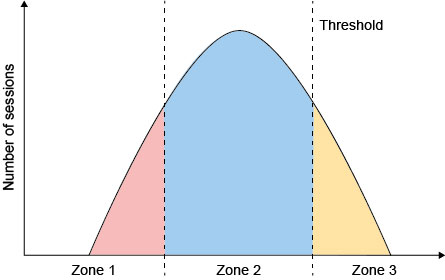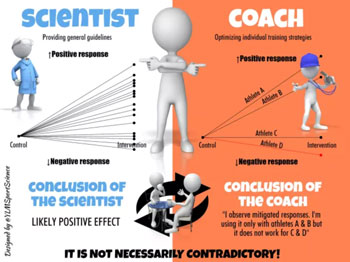6.2 Threshold training
The ‘threshold’ model of TID suggests that the bulk of training should be completed in zone 2 of the three-zone model of intensity (see Figure 7). Threshold training works close to or at your anaerobic threshold and has been shown to be more effective than low-intensity training at generating beneficial endurance adaptations: increased plasma volume, mitochondrial volume, lactate threshold, muscle glycogen storage, muscle capillarisation, stroke volume, cardiac output, VO2 max, slow-twitch muscle fibre hypertrophy and muscle fibre type conversion (type IIb to type IIa; Billat et al., 2003; Coggan, 2016; Fiskerstrand and Seiler, 2004).
Research confirms that elite endurance athletes have adopted a threshold training model, with positive results (Billat et al., 2003; Fiskerstrand and Seiler, 2004). However, training regularly at an increased intensity may lead to an accumulation of stress to the autonomic nervous system (Neal et al., 2012) and increase the risk of injury if insufficient rest is provided (Owen et al., 2015). Now complete Activity 5.
Activity 5
You have considered two TID models as approaches to enhancing endurance performance. If you were Petra’s trainer, which of these models would you advise her to use, and why?
Discussion
A personal trainer or coach should critique the available research in order to be able to select the optimal training strategy for Petra. She is a recreational athlete, and research would suggest that all methods of training would be effective in enhancing her endurance performance in preparation for the marathon. If you investigated further by looking online or in journal articles that compare the models (for example, using Google Scholar) you’ll have discovered that research comparing the effects of polarised and threshold training on endurance performance (for example, time-trial performance, VO2 max, time to exhaustion and RE) suggests that polarised training is the more effective (Neal et al., 2012; Munoz et al., 2014; Rosenblat et al., 2019). However, athletes undertaking polarised training need a lot of time to complete a high volume of training at low intensity, and currently Petra is only completing 2–3 runs a week. Therefore, if Petra has limited time a threshold approach could be adopted but a good pre-habilitative strength programme would be needed to minimise risk of injury.
A personal trainer or coach should use their experience and understanding of the science while factoring in various characteristics of the athlete (that is, experience, environment and relationships) to make an informed decision. The science doesn’t always work for everyone and it’s the job of the trainer/coach to decide.


